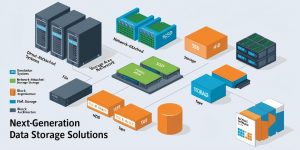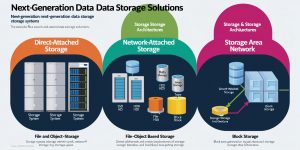In today’s increasingly data-driven world, the volume of digital information is growing exponentially. From businesses and governments to consumers, the need for efficient, secure, and scalable data storage solutions has never been more critical. The U.S. next-generation data storage market is playing a pivotal role in addressing these needs, with innovative technologies that are reshaping the way data is stored, managed, and accessed. This market is experiencing rapid growth, driven by advancements in storage technologies, the rise of cloud computing, and the surge in data generation across industries.

The Rise of Next-Generation Data Storage
Next-generation data storage refers to the evolving technologies designed to address the limitations of traditional storage solutions, such as hard disk drives (HDDs) and legacy storage architectures. These new systems offer enhanced speed, capacity, and security, while also reducing latency and energy consumption. Technologies like solid-state drives (SSDs), storage-class memory (SCM), and 3D NAND flash memory are at the forefront of this transformation, offering faster access to data and greater reliability.
One of the most notable advancements in next-generation storage is the transition to cloud-based storage systems. Cloud storage has become the backbone of modern data management, offering businesses and individuals the ability to store vast amounts of data securely and access it remotely. In fact, cloud storage is expected to drive significant growth in the U.S. next-generation data storage market as organizations embrace scalable, cost-effective, and on-demand storage solutions.
Key Drivers of the Market
Several factors are driving the rapid adoption of next-generation data storage solutions in the U.S.:
Exponential Data Growth: The rapid expansion of data across industries—spurred by the rise of IoT, artificial intelligence (AI), machine learning, and big data analytics—has created an urgent need for more efficient storage solutions. As the volume of data continues to grow, traditional storage methods are no longer sufficient to meet the demands of modern enterprises.
Cloud Computing: Cloud storage platforms, such as Amazon Web Services (AWS), Microsoft Azure, and Google Cloud, are offering highly scalable storage options, which allow businesses to access and store data remotely without the need for on-premises infrastructure. The ability to store and retrieve data on demand has led to a surge in the adoption of cloud storage solutions across various sectors, including finance, healthcare, retail, and manufacturing.
Need for Speed: The increasing demand for real-time data processing has pushed the need for faster data access and retrieval. Next-generation storage solutions, such as SSDs and SCM, provide significant improvements in speed, enabling organizations to handle large data volumes with minimal latency.
Data Security and Compliance: As data breaches and cyberattacks become more frequent, the need for secure storage solutions has grown significantly. Next-generation storage systems offer advanced encryption techniques, multi-factor authentication, and secure data access protocols to help safeguard sensitive information. Additionally, regulatory frameworks like GDPR and CCPA are pushing businesses to adopt more robust data storage solutions that comply with privacy and security requirements.
Cost-Efficiency: The shift to cloud and hybrid cloud storage models is reducing the upfront capital costs associated with maintaining on-premises infrastructure. Moreover, the declining cost of storage media like flash drives and SSDs is making high-performance storage solutions more affordable for businesses of all sizes.
Download PDF Brochure @
https://www.marketsandmarkets.com/pdfdownloadNew.asp?id=12592401

Innovation in U.S. Data Storage Technologies
The U.S. has long been a leader in data storage innovation, with tech giants like Western Digital, Seagate, and Intel driving the development of cutting-edge storage technologies. Some of the most exciting innovations currently shaping the next-generation storage market include:
Solid-State Drives (SSDs): SSDs have become the go-to storage solution for high-performance computing due to their speed, reliability, and low power consumption. Unlike traditional HDDs, which rely on spinning disks, SSDs use flash memory to store data, allowing for faster read and write speeds, reduced boot times, and improved overall system performance.
Storage-Class Memory (SCM): SCM bridges the gap between volatile memory (RAM) and traditional storage, offering high-speed access to persistent data. This technology enables real-time data processing and is expected to play a key role in applications like AI, big data analytics, and IoT, where speed and performance are critical.
3D NAND Flash Memory: This innovative storage technology stacks memory cells in three dimensions, increasing the storage density and reducing the cost per gigabyte. 3D NAND flash memory is paving the way for the development of high-capacity, low-cost storage devices, particularly in the consumer electronics and mobile device markets.
Edge Storage: As more devices and systems move towards edge computing, where data is processed closer to the source, edge storage solutions are becoming increasingly important. Edge storage reduces the need to send data to centralized cloud servers for processing, enabling faster data processing and reducing latency in real-time applications such as autonomous vehicles, industrial automation, and smart cities.
Challenges and Opportunities
While the U.S. next-generation data storage industry holds immense potential, it is not without its challenges. One of the key hurdles is the growing concern over data privacy and security. With the increasing amount of sensitive data being stored and processed, organizations must prioritize robust security measures to protect against data breaches and cyberattacks.
Another challenge lies in the environmental impact of data storage. The rapid growth of data centers, particularly those supporting cloud services, has led to rising energy consumption. However, companies are making strides in addressing this issue by adopting energy-efficient technologies and exploring green storage solutions, such as liquid cooling and renewable energy-powered data centers.
Despite these challenges, the opportunities in the U.S. next-generation data storage market are vast. As industries continue to embrace digital transformation, the demand for scalable, secure, and high-performance storage solutions will only grow. Companies that innovate and adapt to emerging trends, such as AI, edge computing, and blockchain, will be well-positioned to capitalize on the growing market.
The U.S. next-generation data storage market is poised for significant growth, driven by the increasing demand for faster, more secure, and scalable storage solutions. As data generation continues to soar and industries evolve, next-generation storage technologies will play a pivotal role in fueling the data-driven economy. Companies that invest in cutting-edge storage technologies, such as SSDs, SCM, and cloud solutions, will be at the forefront of this transformation, enabling businesses to unlock new possibilities for innovation, efficiency, and growth.
Frequently Asked Questions (FAQ) – U.S. Next-Generation Data Storage Market
1. What is next-generation data storage?
Next-generation data storage refers to innovative storage technologies designed to address the limitations of traditional storage methods. These technologies include solid-state drives (SSDs), storage-class memory (SCM), 3D NAND flash memory, and cloud-based storage solutions that provide faster, more reliable, scalable, and secure data management.
2. What are the key drivers of growth in the U.S. next-generation data storage market?
The major factors driving growth in the market include:
-
Exponential data growth from IoT, AI, big data analytics, and cloud computing.
-
Cloud computing adoption, offering scalable and cost-effective storage solutions.
-
The increasing need for faster data access and low-latency performance.
-
Data security and compliance with regulations like GDPR and CCPA.
-
Cost efficiency and reduced capital expenditures through cloud and hybrid cloud solutions.
3. How does solid-state storage differ from traditional hard drives?
Solid-state drives (SSDs) use flash memory to store data, providing significantly faster read/write speeds, lower power consumption, and higher durability compared to traditional hard disk drives (HDDs), which use mechanical parts. SSDs are more reliable and are ideal for high-performance computing environments.
4. What role does cloud storage play in the market?
Cloud storage plays a critical role by offering scalable, on-demand storage without the need for on-premises infrastructure. It enables businesses to store large volumes of data efficiently, with the flexibility to access data remotely. Major cloud service providers such as AWS, Microsoft Azure, and Google Cloud are leading the adoption of cloud storage solutions.
